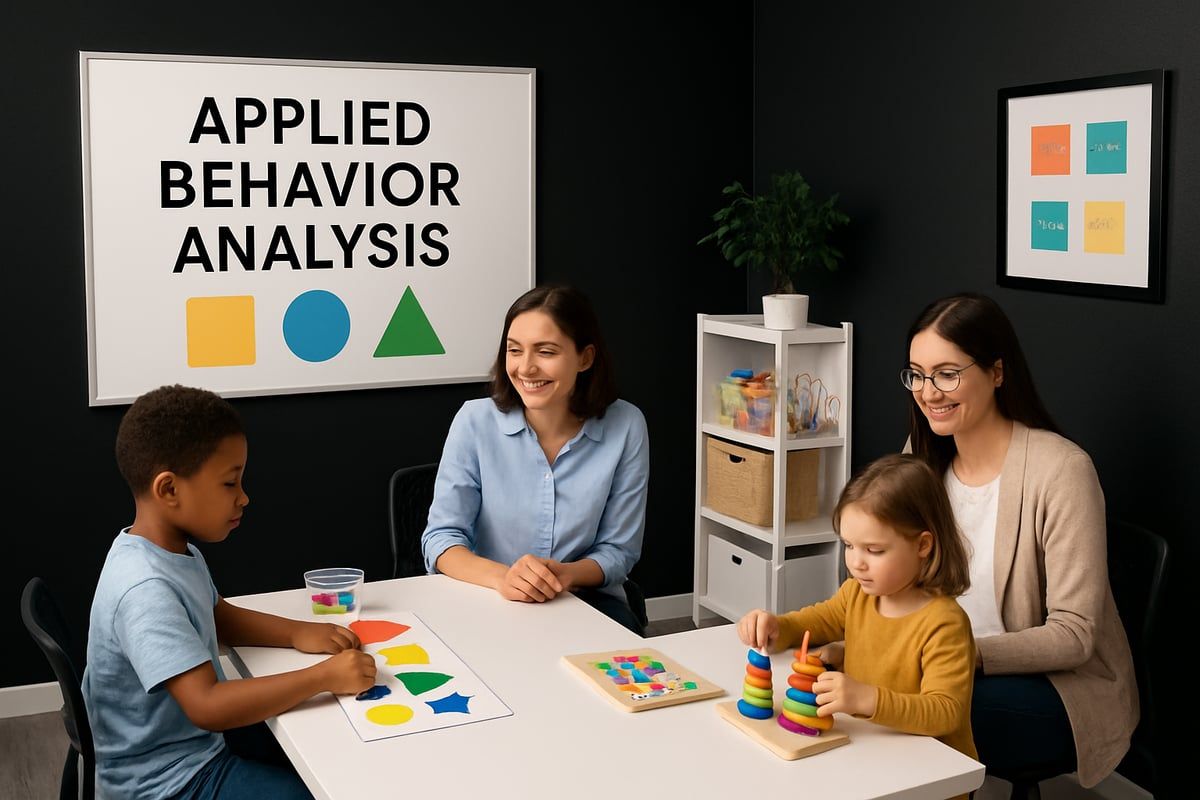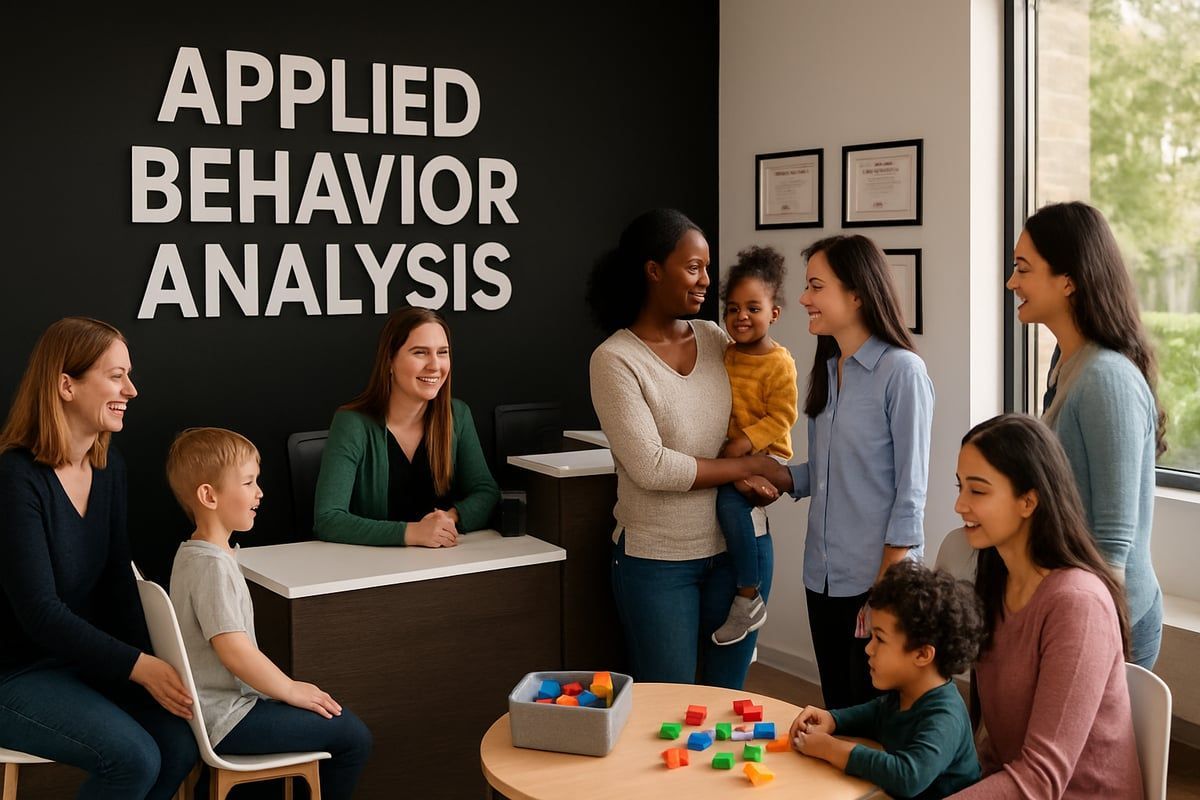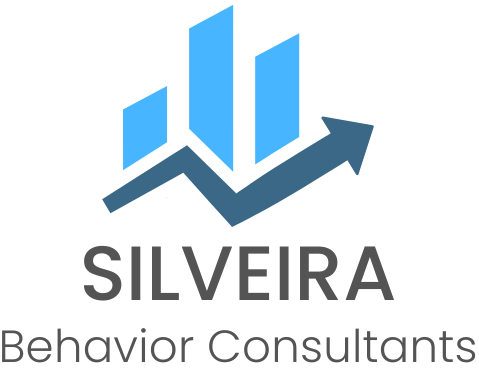Applied behavior analysis (ABA) clinic services are transforming how individuals with autism and developmental disabilities achieve meaningful growth. In 2025, families, caregivers, and professionals face more choices and higher standards than ever before.
This essential guide explains what to expect from an ABA clinic, how to select the best fit, and the trends shaping ABA care. From understanding the science behind ABA to practical tips for measuring progress, you’ll gain the confidence to make informed decisions.
Ready to discover how the right clinic can open doors to lasting positive change? Let’s get started.
Understanding Applied Behavior Analysis (ABA) (H2)
To understand the role and impact of an ABA clinic, it’s important to start with the science behind applied behavior analysis. ABA is an evidence‑based approach that has transformed how individuals with autism and developmental disabilities learn, adapt, and thrive.
By focusing on measurable behaviors and structured interventions, ABA provides families and professionals with proven strategies for skill development, independence, and long‑term success. Modern clinics are built on these principles, ensuring that therapy is both effective and tailored to individual needs.

What is Applied Behavior Analysis (ABA)?
Applied Behavior Analysis (ABA) is a scientific approach to understanding and improving behavior. Rooted in learning theory, ABA uses principles such as reinforcement, prompting, and shaping to teach meaningful skills. Since its development in the mid‑20th century, research has consistently confirmed its effectiveness for individuals with autism and developmental disabilities.
Key ABA Concepts
- Reinforcement: Encouraging positive behaviors.
- Prompting: Guiding learners toward correct responses.
- Shaping: Gradually building complex skills.
For example, therapists in an ABA clinic may teach a child to request items using words or gestures. According to the CDC, over 80% of children receiving early ABA intervention make significant progress.
To explore these foundational methods further, see the Principles of Applied Behavior Analysis.
The Role of ABA Clinics
An applied behavior analysis clinic provides a structured environment designed for intensive therapy. Unlike in‑home or school‑based ABA, clinics offer consistent routines, specialized resources, and a team of trained professionals.
Benefits of Clinic‑Based ABA
- Access to group social skills activities
- Reliable data collection and progress monitoring
- Opportunities for peer interaction in a safe, supportive setting
For instance, many clinics run social skills groups where children practice communication with peers. This clinic‑based model ensures therapy sessions remain focused, individualized, and effective.
Populations Served by ABA Clinics
While ABA clinics primarily serve individuals with autism spectrum disorder (ASD), they also support those with ADHD, developmental delays, and behavioral challenges.
Services span across age groups—from toddlers in early intervention programs to adolescents and, in some cases, adults. According to the CDC, 1 in 36 children were diagnosed with ASD in 2024, underscoring the growing demand for ABA services.
Clinics tailor programs based on age, diagnosis, and individual goals, ensuring each client receives personalized support.
Evidence‑Based Effectiveness
Decades of research validate the effectiveness of ABA clinics. Endorsements from organizations such as the American Psychological Association and the U.S. Surgeon General highlight ABA’s impact.
Documented Outcomes
- Improved communication abilities
- Enhanced daily living and adaptive skills
- Reduced challenging behaviors
Long‑term studies show that gains achieved in ABA clinics are often sustained, helping clients succeed at home, school, and within their communities.
Common Misconceptions and Ethical Considerations
Despite its success, misconceptions persist. Some critics believe ABA creates “robotic” behaviors or overlooks individuality. In reality, ABA clinics follow ethical guidelines that prioritize dignity, consent, and personalized care.
Board Certified Behavior Analysts (BCBAs) oversee treatment to ensure best practices. When ethical dilemmas arise, clinics involve families and professionals to find respectful, effective solutions. Ongoing training and adherence to ethical standards build trust and maintain high‑quality care.
Choosing the Right ABA Clinic (H2)
Selecting the right ABA clinic can feel overwhelming, but knowing what to look for makes the process manageable. The right clinic can be life‑changing for families and individuals seeking support.
Key Factors to Consider
- Staff credentials and BCBA oversight
- Family involvement in treatment planning
- Clear progress monitoring and reporting
- Inclusive programs tailored to age and diagnosis
By evaluating these factors, families can confidently choose a clinic that aligns with their needs and values.
Key Qualities of a High‑Quality ABA Clinic
A standout applied behavior analysis clinic demonstrates accreditation, state licensing, and a highly trained team. Look for Board Certified Behavior Analysts (BCBAs) and Registered Behavior Technicians (RBTs) on staff, as these professionals ensure evidence‑based care and uphold ethical standards.
Family involvement is equally crucial. High‑quality clinics welcome parents into the treatment process, provide transparency in progress, and make data‑driven decisions. Touring the facility, meeting staff, and speaking with current families can provide valuable insights.

For more guidance, explore resources such as Choosing ABA Therapy Centers for in‑depth tips on selecting the right clinic.
Assessing Clinic Services and Specializations
Every ABA clinic should offer a broad range of evidence‑based services. Common options include early intervention for toddlers, school readiness programs, social skills groups, and parent training workshops.
Customization matters. Top clinics provide culturally competent care, bilingual services, and adapt programs for diverse populations. Ask about individual versus group therapy options, and whether specialized tracks exist for adolescents or adults.
When evaluating a clinic, request details on their unique offerings. Clinics that adapt to individual needs are better equipped to support meaningful progress.
Evaluating Clinic Outcomes and Success Rates
How does an ABA clinic measure progress? Reliable clinics use standardized assessment tools such as the VB‑MAPP and ABLLS‑R to track client growth. Regular data sharing with families—through meetings or digital reports—keeps everyone informed and engaged.
Look for clinics that openly report outcomes and success rates. Industry data shows that clinics with consistent parent communication often achieve higher satisfaction. Transparent progress measurement reflects a clinic’s commitment to accountability and continuous improvement.
When considering a clinic, ask to see sample progress reports and data visualization methods.
Insurance, Funding, and Accessibility
Navigating insurance and funding options is a critical step in choosing an ABA clinic. In 2025, most states mandate some level of insurance coverage for ABA therapy, though specifics vary. Ask clinics about accepted insurance plans, public versus private funding, and any out‑of‑pocket costs.
Waitlists can be a barrier. Inquire about current wait times and strategies clinics use to expedite access to care. Some clinics assist families in tapping into state mandates or grants, making services more accessible.
Choosing a clinic that supports you through the funding process can relieve financial stress and improve continuity of care.
Silveira Behavior Consultants: Personalized ABA Services
Silveira Behavior Consultants is an ABA clinic offering personalized therapy across clinics, homes, and schools. Led by a Board Certified Behavior Analyst with over 20 years of experience, the clinic provides comprehensive ABA services, parent training, school consultation, and bilingual support.
Affordability and cultural sensitivity are central to their approach. Families benefit from holistic support, flexible service models, and measurable progress. Silveira’s individualized strategies ensure each client’s unique strengths and needs are addressed.
Prospective clients can contact Silveira Behavior Consultants for tailored solutions and compassionate guidance on their ABA journey.
Red Flags and Questions to Ask
When touring an ABA clinic, watch for warning signs. High staff turnover, lack of transparency, and unlicensed practitioners are red flags. A quality clinic should maintain stability and open communication.
Key Questions for Families
- What is your staff‑to‑client ratio?
- How do you involve parents in treatment?
- How is progress tracked and reported?
Bring a checklist during your initial visit. Data shows clinics with low staff turnover have 30% better client retention, so don’t hesitate to ask about team stability. Choosing the right clinic is about finding a trusted partner for your family’s success.
The ABA Clinic Intake and Assessment Process
Beginning services at an ABA clinic can feel overwhelming, but understanding the intake and assessment process removes much of the mystery. Each step is designed to ensure a tailored approach for every individual and family.
From the first contact to the start of therapy, clinics typically conduct interviews, gather background information, and perform assessments to create individualized treatment plans. This structured process ensures that therapy is aligned with each client’s unique goals.

Initial Consultation and Family Interview
Your journey with an applied behavior analysis clinic typically begins with an initial consultation. This first meeting allows the clinical team to learn about your child’s developmental history, strengths, and challenges.
Families often complete a detailed intake questionnaire before the consultation. During the interview, clinicians ask about communication, social skills, daily routines, and specific concerns. Family insights are critical in shaping priorities for assessment and future therapy.
Many clinics use structured templates for parent interviews. These tools guide the conversation and ensure all relevant areas are explored, making it easier for families to share experiences and goals.
Comprehensive Behavioral Assessment
Following the initial interview, the clinic conducts a comprehensive behavioral assessment. This phase includes direct observations and standardized tools such as the Vineland Adaptive Behavior Scales and the VB‑MAPP to gather detailed information.
A key component is the Functional Behavior Assessment (FBA), which identifies why certain behaviors occur. Baseline data is collected to establish a starting point for measuring progress.
For example, a case study may show how a thorough FBA led to new communication goals and reduced challenging behaviors. Assessment‑driven planning ensures interventions are effective and individualized.
Individualized Treatment Planning
Once assessments are complete, the clinic team collaborates with families to develop a custom treatment plan. Goals are measurable and achievable, focusing on communication, social interaction, and daily living skills.
Clinicians, parents, and sometimes school staff work together to prioritize targets. Data from assessments guide intervention choices. Each plan is unique, reflecting the needs and values of the individual and their family.
A sample plan might include objectives for requesting help, joining group activities, or managing transitions, with regular reviews to ensure ongoing progress.
Insurance Authorization and Paperwork
Securing insurance approval is a crucial step in starting ABA services. Families are guided through completing forms, gathering documentation, and submitting requests for authorization.
Clinics often provide checklists to help families stay organized. Timelines can vary, so knowing what to expect reduces stress. If insurance denies a request, clinicians support families through the appeals process.
Having paperwork ready speeds up therapy initiation. A typical checklist includes proof of diagnosis, prior assessments, and authorization forms—ensuring nothing is overlooked.
Onboarding and Transition to Services
Once approval is secured, the clinic helps families prepare for the transition to therapy. Orientation sessions introduce the clinical team, review schedules, and explain what a typical day looks like.
Children may benefit from social stories or visual schedules to make the new environment less intimidating. Staff are trained to support smooth transitions, answer questions, and address concerns.
A well‑planned onboarding process builds trust and sets the stage for success. Families leave orientation with a clear understanding of next steps and points of contact.
Implementing ABA Therapy: Clinic Operations and Best Practices
Operating an ABA clinic requires a blend of clinical expertise, structured routines, and family‑centered care. Every detail—from daily schedules to data systems—is designed to promote meaningful progress and positive experiences.
Best practices include consistent data collection, individualized programming, and ongoing collaboration with families. By combining evidence‑based methods with compassionate care, clinics ensure therapy remains effective, transparent, and supportive.
Structure of ABA Sessions
A typical day at an applied behavior analysis clinic is thoughtfully structured to maximize learning. Sessions often run between two and four hours, tailored to each individual’s needs and goals.
Therapists incorporate discrete trial training (DTT), natural environment teaching (NET), and group activities. For example, a session may begin with focused skill‑building, transition into play‑based learning, and conclude with social group exercises. This blend promotes engagement, generalization, and long‑term skill retention.

Role of the Interdisciplinary Team
Collaboration is central to ABA clinic success. Board Certified Behavior Analysts (BCBAs) oversee treatment plans, while Registered Behavior Technicians (RBTs) deliver day‑to‑day interventions.
Many clinics also include speech‑language pathologists, occupational therapists, and counselors as part of the team. Regular meetings ensure alignment, allowing professionals to share observations and adjust strategies. This interdisciplinary approach creates a robust support system where each expert contributes unique insights for comprehensive care.
Parent and Caregiver Involvement
Family engagement is a cornerstone of success in ABA therapy. Parents and caregivers participate through training workshops, home program integration, and progress meetings.
Clinics may offer digital portals for communication, enabling families to review goals, ask questions, and access resources. This ongoing involvement ensures consistency between clinic and home. Empowering families to actively participate reinforces skills and fosters trust throughout the therapy journey.
Data Collection and Progress Monitoring
Data‑driven decision making is at the heart of ABA clinics. Therapists use electronic health records and real‑time tracking systems to monitor progress.
Behavioral trends are analyzed weekly, guiding adjustments to interventions. Visual dashboards and graphs help families celebrate milestones and understand progress. This transparent approach ensures goals remain on track and interventions are tailored for optimal results.
Addressing Challenging Behaviors
Proactive strategies are essential for managing challenging behaviors. Clinicians use antecedent interventions, positive reinforcement, and individualized behavior intervention plans (BIPs).
When crisis situations arise, clear protocols and safety plans are in place. For example, a child exhibiting aggression may benefit from a plan that teaches alternative communication skills. These strategies are regularly reviewed and adjusted, ensuring safety and progress for every client.
Ensuring Cultural Competence and Accessibility
A truly effective ABA clinic embraces diversity. Interventions are adapted for cultural backgrounds, languages, and family values.
Clinics offer bilingual services, culturally relevant materials, and flexible scheduling. Staff receive ongoing training to address cultural nuances and remove barriers to care. By prioritizing accessibility and respect, clinics create welcoming environments where every family feels understood and supported.
Measuring Progress and Ensuring Quality Outcomes
Tracking progress is central to ABA therapy. By focusing on measurable outcomes, clinics empower families, caregivers, and professionals to see real, lasting change.
Setting and Reviewing Treatment Goals
Every ABA clinic begins with clear, individualized goals. Clinicians use the SMART framework (Specific, Measurable, Achievable, Relevant, Time‑bound) to ensure objectives are tailored to each client.
Goals are reviewed regularly in collaboration with families. This ongoing process allows for quick adjustments to new strengths or emerging needs. For example, a child’s communication goal may evolve from requesting items with pictures to using spoken words.
Clinics encourage families to participate in goal‑setting meetings. This partnership aligns therapy with real‑life priorities, making success more meaningful.
Simple Progress Review Checklist
- Review SMART goals regularly
- Track weekly behavioral data
- Share updates with families
- Adjust interventions based on progress
- Celebrate milestones together
| Review Item | Frequency | Responsible Party |
| Goal review | Monthly | Clinician & Family |
| Data update | Weekly | Technician/BCBA |
| Family feedback | Ongoing | Family |
Objective Data Analysis and Reporting
Data drives decision‑making in an applied behavior analysis clinic. Clinicians collect and graph data on every target behavior, making trends easy to identify. Families receive regular, easy‑to‑understand reports—often with visual graphs that highlight growth and progress.
Standardized tools such as the VB‑MAPP and ABLLS‑R provide objective benchmarks. Reports are shared during parent meetings, through secure portals, or as printed summaries.
Effective clinics follow ABA industry guidelines to ensure data collection and reporting methods meet best‑practice standards. By prioritizing transparency, clinics reinforce trust and keep families informed every step of the way.
Discharge Planning and Transition Support
When a client is ready to move on, the ABA clinic guides the transition with clear discharge planning. Criteria for program completion may include mastery of goals, independence skills, or readiness for school.
Transition Process Checklist
- Create a detailed transition checklist
- Share progress and recommendations with new providers or schools
- Prepare families for next steps through meetings and social stories
Support doesn’t end at discharge. Many clinics offer follow‑up consultations to ensure continued success. This comprehensive approach reflects the clinic’s commitment to lifelong growth.
Quality Assurance and Continuous Improvement
High‑quality ABA clinics continually raise their standards. Quality assurance includes regular audits, peer reviews, and family feedback surveys.
Clinics may also seek external accreditation, following updated ABA accreditation standards 2025 to demonstrate excellence.
Continuous Improvement Activities
- Annual service reviews
- Staff training updates
- Implementing new research findings
By embracing quality assurance, clinics create a culture of accountability, ensuring the best possible outcomes for every client.
Future Trends and Innovations in ABA Clinics for 2025
The future of ABA clinics is rapidly evolving, driven by technology, best‑practice shifts, and expanded access. Families and professionals can expect more personalized, data‑driven, and accessible services than ever before.
Advances in Technology and Telehealth
Telehealth is now a mainstream option, allowing families to access therapy and parent training from anywhere. Digital platforms streamline data collection and enable real‑time progress tracking.
Artificial intelligence is beginning to play a role, analyzing behavioral data, suggesting personalized interventions, and improving outcomes. For example, virtual parent training modules increase engagement and flexibility.
Evolving Best Practices and Regulatory Changes
Best practices in ABA are shifting toward trauma‑informed care, prioritizing dignity and individualized interventions.
Regulatory standards are also changing. The Behavior Analyst Certification Board (BACB) continues to update certification and ethical guidelines. Nonprofit accreditation is gaining attention as a way to promote consistent quality across services.
Expanding Access and Equity in ABA Services
ABA clinics in 2025 are focused on reducing waitlists and expanding access. Mobile therapy units, community partnerships, and outreach programs help underserved families receive vital support.
Cultural competence is a priority, with bilingual services and culturally relevant materials offered to diverse populations. Policy advocacy is also expanding insurance coverage and funding, making therapy more affordable.
Silveira Behavior Consultants: Personalized ABA Services
At Silveira Behavior Consultants, we guide families through every step—from understanding ABA basics to building personalized therapy plans that empower growth and independence.
Led by experienced BCBAs, our clinic offers individualized strategies, bilingual support, and family‑centered care. We are passionate about helping families achieve meaningful progress with compassion and expertise.
Inquire About Services to see how our team can support your unique goals with confidence.





